On 28 March 2023, representatives of the European Commission, the European Parliament and the Council of the European Union (EU) agreed on a compromise on the EU Alternative Fuels Infrastructure Regulation (AFIR).
The AFIR, proposed by the European Commission on 14 July 2021, is part of the EU’s “Fit for 55” package, a package of regulatory measures to make EU policies fit to reduce net greenhouse gas emissions by at least 55% by 2030. It sets out for the first Once national and legally binding targets at EU level for the deployment of alternative fuel infrastructure for road vehicles, ships and stationary aircraft.
Ordinary EU legislative procedure requires the co-legislators (the European Parliament and the Council of the European Union) to approve the European Commission’s proposal. The Council adopted its position on inter-institutional negotiations on 2 June 2022. The European Parliament in turn voted on its negotiating position in plenary on 19 October 2022. In four rounds of tripartite meetings, representatives of the European Commission and the European Commission voted and the Parliament and the European Council discussed their positions. They agreed to a compromise on March 28, 2023.
This regulation requires Member States to ensure that a total energy output of at least 1.3 kW per battery electric car or van and 0.8 kW per hybrid registered in their territory is provided through publicly accessible recharging stations. Furthermore, Member States must ensure that a fast charging dock is installed every 60 kilometers in each direction of travel by 2025 along the core TEN-T network and by 2030 along the comprehensive TEN-T network. For trucks and buses, AFIR includes a combined approach for remote targets along the TEN-T, targets for recharging infrastructure in safe and secure parking areas, and targets in urban nodes. For remote targets, 15% of the total TEN-T (basic and universal) must be equipped with fast charging stations at least every 120 km, increasing to 50% by 2027, and 100% by 2030. Minimum capacity and limit are also included Maximum distance between hydrogen refueling stations for trucks.
The ICCT Policy Update on AFIR provides an overview of this regulation. Highlights include:
Overview of fleet-based and remote AFIR targets for passenger cars and vans; Overview of distance-based targets, targets for recharging infrastructure in safe and secure parking areas, and targets at urban points for trucks and buses. and an overview of other features of AFIR, including ease of use, exceptions, and reporting requirements.





